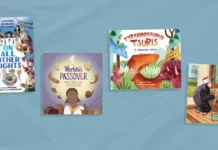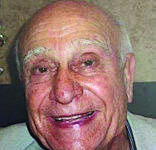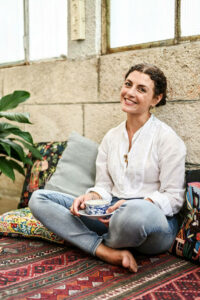
Orit Arfa | JNS.org
For most Jews, a sukkah conjures a booth with canvas or wooden walls, and bamboo or some sort of foliage on top as schach.
Growing up in Sydney, Sarah Sassoon, 42, had a very different experience. The sukkahs that her Iraqi-born father made were composed mostly of palm tree branches — both walls and schach.
That and other Iraqi-Jewish traditions can offer hints of what Judean practices were like 2,000 years ago, according to Sassoon. Iraqi Jews, or “Babylonian Jews,” as she prefers to call them, are the closest geographically and historically to the exile of the Kingdom of Judah to Babylon in the late sixth century BCE.
“Palm trees are such a deep symbol,” including on ancient Judean coins, Sassoon said in a video call from her home in Jerusalem, where she lives with her husband and four sons.
An ancient community
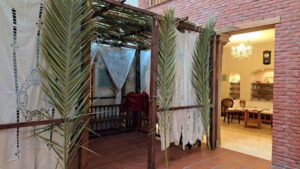
From a young age, Sassoon’s Iraqi roots interested her, and she clung to her grandmother’s side as the latter cooked and baked Iraqi delights.
When she made aliyah eight years ago and interacted with more Iraqi Jews, she decided to make it her mission to rediscover, animate and immortalize those traditions and to demonstrate that Iraqi Jewish life is about more than just foods like kubbe and sabich.
“They were an ancient Jewish community, with a richness and with customs that go back all the way to talmudic times and Temple times,” Sassoon said. “It’s a community that every Jew actually should know about and belong to because every Jew went through Babylon into the Diaspora.”
Many Jews are familiar with the Babylonian Talmud, which Torah scholars of the region produced, but they might not know that modern Iraq is home to what some believe is the tomb of the biblical scribe Ezra, who led Babylonian Jews to Jerusalem to build the Second Temple.
On Sukkot, Jews used to visit the shrine (Ezra’s Tomb) in Al-ʻUzair, outside of Baghdad. Local Muslims have painted the shrine green — a color sacred in Islam — though Hebrew inscriptions remain visible on the site, she has heard from local Iraqis.
One-third of Baghdad’s population was Jewish in 1917, and Jews held top political, business and cultural positions, according to Sassoon, who hails from a prominent Iraqi Jewish family. Her great-great-grandfather, Moshe Chaim Shamash, was the chief rabbi (hakham bashi) of Iraq from 1918 to 1923 and mediated between the Jewish community and political leaders. Her maiden name is “Harkham,” which derives from chacham, Hebrew for “sage.”
Modern Iraqis, whom Sassoon has met on social media, tell her that her grandparents’ generation misses the Jews. According to reports, less than a handful of Jews live in Iraq today; however, Sassoon says there are Jews there who hide their identity, as well as Jewish converts to Islam.
“They really were very integrated,” Sassoon said of Iraq’s past Jewish population. “They were very much part of Iraqi society. It was as if American Jews suddenly left overnight.”
In the shadows of the Farhud
Sassoon’s award-winning children’s book, “Shoham’s Bangle” (2022), dramatizes Jewish flight from Iraq during the foundation of the modern state of Israel through the eyes of a young Jewish girl.
Shoham is fascinated by her Nana Aziza’s golden bangles, bracelets worn by Iraqi Jewish and Muslim women. Shoham is sad to leave the heirlooms behind, but it turns out that her sense of loss may have been premature.
Sassoon, who penned the book — her first for children — in a writers’ workshop in Jerusalem, found that success came quickly and unexpectedly. She submitted the manuscript to Kar-Ben Publishing, which accepted it. “I was lucky,” she said. Subsequently, she secured literary representation with a leading agency in Jerusalem.
The protagonist of her second and forthcoming children’s book, “This Is Not a Cholent,” is tibit, the Iraqi-Jewish version of cholent made with rice and chicken. She is also working on a novel about a young Jewish woman growing up in Baghdad in the shadows of the 1941 Farhud massacre, in which thousands of Jews were murdered, injured or dispossessed of their property.
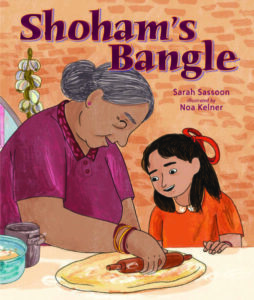
‘Overhear the learning and be a part of it’
The more she tells the stories of the women of her grandmother’s generation, the more Sassoon paradoxically deviates from their experience. Many Iraqi women were illiterate housewives, she said.
But a seed of what one might call feminist empowerment may have been planted on the holiday of Hoshanah Rabbah, the last day of Sukkot. Iraqi women pulled all-nighters with the men, studying Torah and other sacred texts in the sukkah.
The women multi-tasked in the back of the sukkah, making and shaping a risotto-like pasta called sha’ariya.
“It’s fascinating to think the women used to learn with the men in that way,” Sassoon said. “That they’d overhear the learning and also be a part of it. And the next day, they’d cook the pasta pieces.”
Sassoon is dedicated to recreating Iraqi traditions, but some aren’t feasible. She loves the idea of studying Torah in the sukkah with men, but making sha’ariya “is beyond me,” she said.
She also has had difficulty tracking down the chrai used for Shabbat candlelighting, which she thinks must have been the way Jews lit Shabbat candles in talmudic times.
“It’s a glass bowl held up by three silver chains. Inside is water and sesame oil, with seven wicks attached to cotton wicks, and they light seven of those for the Friday night candles,” she said. “There’s no such thing as Iraqi Jewish candlesticks. I always wondered: Why didn’t my grandmother have silver candlesticks?”
On Sukkot, Iraqi Jews light the chrai every night to welcome the seven “founding fathers” of the Jewish people, known as ushpizin, who “visit” sukkahs each night of the eight-day holiday.
Sassoon will decorate her sukkah with palm tree branches and hang fresh pomegranates like her forebears. For now, though, she’ll use the candlesticks that her Czech mother-in-law gave her.



